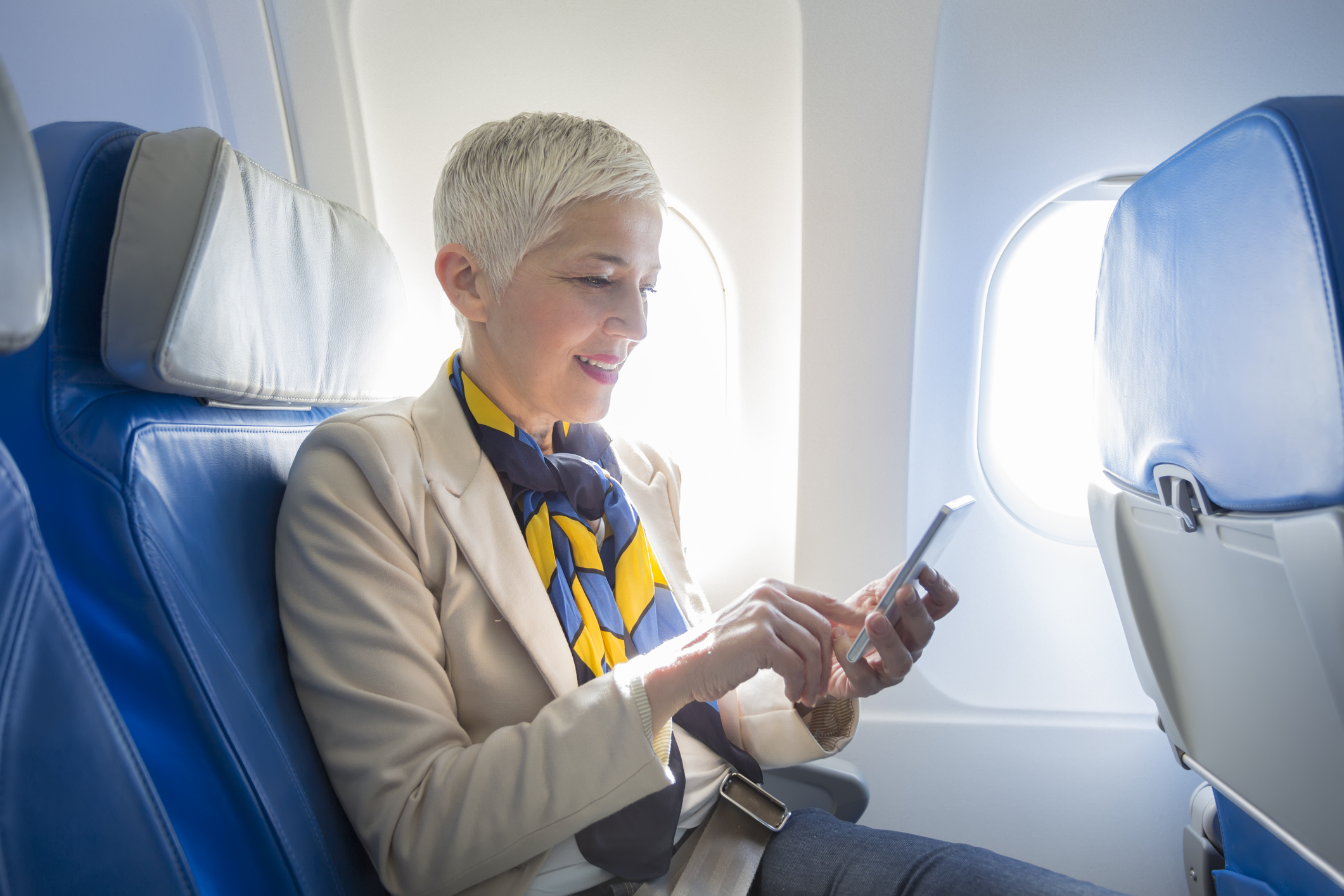International Phone Plans for Travel: 5 Smart Ways to Save on Your Phone Bill When Abroad
From international plans to eSIMs and Wi-Fi tricks — practical tips to stay connected abroad without the sticker shock.

Donna LeValley
Not long ago, a man from the U.S. returned home from a trip to Europe to a $143,000 T-Mobile bill, apparently because the phone had not been set up for international roaming, according to an article in The Guardian.
Considering that 1.4 billion people traveled globally in 2024, there’s a real chance you, too, may come home to a high cell phone bill, especially if you don't determine your needs (or wants) before you use your phone when traveling abroad.
Although using your smartphone has become a necessary part of international travel, roaming fees alone can be exorbitant, and depending on your carrier, using data outside the U.S. is also at a premium. What is the right way to set up your phone when traveling internationally? Here are five tips.
From just $107.88 $24.99 for Kiplinger Personal Finance
Become a smarter, better informed investor. Subscribe from just $107.88 $24.99, plus get up to 4 Special Issues

Sign up for Kiplinger’s Free Newsletters
Profit and prosper with the best of expert advice on investing, taxes, retirement, personal finance and more - straight to your e-mail.
Profit and prosper with the best of expert advice - straight to your e-mail.
1. Ask about your provider's international phone plans
The first thing to do before traveling overseas is to check out your service provider’s policy regarding international cell phone use. Although you may want to reach out a few months before traveling, check back often, as policies can change.
You may also want to see what your current contract does and doesn’t allow.
In the past, global roaming was an extra feature you could opt into for an additional fee. However, many service providers now activate international texting, calling and data features automatically as soon as you use your phone in a foreign country.
Just understand that this feature can be pricey, so if you plan on traveling for a long time, find out ahead of time if it’s worth the price.
This is a good place to start if you're booking a cruise. Since standard travel or roaming plans don't always include maritime networks, you'll want to contact your provider about using your cell phone on a cruise. If they don't offer cruise-specific plans, you may have to pay for pricier Wi-Fi plans on board or commit to only using your phone on land.
2. Use temporary data passes when traveling abroad

When traveling abroad, you may find you need extra data because you want a higher data speed, the ability to stream HD video or you’ve reached your data allotment.
Providers like T-Mobile, Verizon and AT&T all provide temporary data passes — although they have different names — that each provide a set amount of roaming data that you can use for a certain amount of time for one price.
Unfortunately, these temporary data passes can be expensive. Verizon, for instance, recently raised its daily price from $10 to $12. But if you can’t unlock your phone, these are a good option.
T-Mobile's International Pass gives you:
- $5 for 24 hours of unlimited calling and 512MB of high-speed international data
- $35 for 10 days of unlimited calling and 5GB of high-speed international data
- $50 for 30 days of unlimited calling and 15GB of high-speed international data
Verizon’s TravelPass gives you:
- $12 per day unlimited calls, data and texts
- $6 per day for the same in Mexico and Canada
AT&T’s International Day Pass gives you:
- $12 per day unlimited data, talk and text
- $6 for each additional line
- $20 per day for use on land and sea during a cruise
Traveling this summer? Earn rewards faster and enjoy exclusive perks when you add one of Kiplinger's top airline cards to your wallet, powered by Bankrate. Advertising disclosure.
3. Swap your SIM card

Renting a SIM card allows you to make calls or text and use data by swapping out your current SIM card for one compatible with the country you're visiting. When you rent a new SIM card, you’ll get a new number, so you won’t be able to receive calls or texts on your regular phone number.
Before you go, make sure to notify family and friends so they can contact you via a chat app like WhatsApp or Facebook Messenger instead. Even so, renting a card is generally a much cheaper option than paying for an international roaming service.
Specialized stores in major airports and cell phone companies often offer SIM card rental. In fact, Amazon sells SIM cards for Europe ranging from around $20-$50, typically for 30 days of use.
You should make sure you can change your phone's SIM card and that you know how to do it before you take this route. Note that it is possible to change SIM cards on iPhones, but if you have an iPhone 14 or later model, you'll need to use an eSIM card.
Unlike the regular SIM cards you remove from a phone, an eSIM is a microchip embedded in the phone’s hardware and is especially useful when you’re traveling internationally.
According to AARP, you can purchase data through eSIM providers such as GigSky, Airalo, Nomad and Flexiroam, or you can add an eSIM from a local provider in the country you’re visiting.
Orange Holiday sim card for travelers arriving in Europe. Stays active for 30 days from first use, delivers high‑speed 4G/LTE data, includes free hotspot use and comes with a SIM holder and pin.
4. Get an international phone
If you think you will make many calls or use your phone extensively while visiting another country, consider purchasing an international phone. These international mobile phones often come with reduced international roaming rates and data.
You can try doing this when you arrive at your destination, just be aware of language barriers and have an idea of what you're looking for before you get to a store.
5. Turn off your data and use Wi-Fi instead

If you don't need your phone to be constantly connected on your trip, the best way to save is by simply turning off your data and using your phone only when you're in range of Wi-Fi.
Using free Wi-Fi and otherwise turning off cell service is Kiplinger digital managing editor Alexandra Svokos' preferred method for using her phone when traveling.
"I have an iPhone, and iMessage and FaceTime only need Wi-Fi to work, so I set my phone to 'airplane' mode, text or FaceTime my family to keep in touch when I'm at the hotel with Wi-Fi, and then I'll go out and be in the moment when I'm visiting sites," she said.
Here are some useful tips for changing your phone settings to avoid using data while roaming:
- Turn off data roaming in your phone’s settings before you land in your destination. This will stop your phone from connecting to international cell towers to send and receive calls and texts.
- Turn on airplane mode. Another way to prevent your phone from using data while roaming is to keep airplane mode on permanently. You'll still be able to manually connect to Wi-Fi networks or Bluetooth as needed.
- Download maps of whole cities or regions on Google Maps before you're trip so you can use them even when you aren't in range of Wi-Fi. This is also useful if you're traveling somewhere with poor service, even in the U.S.
- If you use an app like AllTrails for hikes, you can get AllTrails+ for $36 a year, and then you're able to download maps to navigate when you're offline or away from data.
- Ask the employees at cafes, restaurants, and other places you visit while you're abroad for the Wi-Fi password. Many places offer it freely to customers. Plus, once connected, you can always walk back in range of that cafe or restaurant any time during your trip if you need to check something or send a text while you're out.
Just remember to have an emergency plan, Svokos said.
"I try to use paid international cell service as little as possible, but I'm also comfortable doing that because I know if I'm in a crunch and need service, I can just turn off 'airplane' mode and my Verizon plan will automatically give me 24 hours of international service for $12," she said. "It also becomes a sort of game with myself to see how few days I actually need to have data, versus just using free Wi-Fi."
Best phone plans for international travel
When traveling abroad, choose an unlimited data plan, which often offers the most travel-related perks.
Then, depending on your needs, check out these options, chosen by Tom's Guide as the best unlimited plans:
- Google Fi: Best choice for travelers
- Visible by Verizon: Best overall
- T-Mobile Go5G: Best family option with unlimited data
No matter where you're going, you want your phone to be the last thing giving you trouble. Make a plan, then go have fun, there's a whole world out there beyond your phone.
Related Content
Profit and prosper with the best of Kiplinger's advice on investing, taxes, retirement, personal finance and much more. Delivered daily. Enter your email in the box and click Sign Me Up.

For the past 18+ years, Kathryn has highlighted the humanity in personal finance by shaping stories that identify the opportunities and obstacles in managing a person's finances. All the same, she’ll jump on other equally important topics if needed. Kathryn graduated with a degree in Journalism and lives in Duluth, Minnesota. She joined Kiplinger in 2023 as a contributor.
- Donna LeValleyRetirement Writer
-
 How to Protect Yourself and Others From a Troubled Adult Child
How to Protect Yourself and Others From a Troubled Adult ChildThis case of a violent adult son whose parents are in denial is an example of the extreme risks some parents face if they neglect essential safety precautions.
-
 To Build Client Relationships That Last, Embrace Simplicity
To Build Client Relationships That Last, Embrace SimplicityAs more automation becomes the norm, you can distinguish yourself as a financial professional by using technology wisely and prioritizing personal touches.
-
 Client Demand Is Forcing Advisers to Specialize: How to Deliver
Client Demand Is Forcing Advisers to Specialize: How to DeliverThe complexity of wealthy clients' needs — combined with AI and consumer demand — suggests the future of financial planning belongs to specialized experts.
-
 How to Protect Yourself and Others From a Troubled Adult Child: A Lesson from Real Life
How to Protect Yourself and Others From a Troubled Adult Child: A Lesson from Real LifeThis case of a violent adult son whose parents are in denial is an example of the extreme risks some parents face if they neglect essential safety precautions.
-
 Here's How Much You Can Earn with a $100,000 Jumbo CD
Here's How Much You Can Earn with a $100,000 Jumbo CDYou might be surprised at how fast a jumbo CD helps you reach your goals.
-
 A Financial Planner Takes a Deep Dive Into How Charitable Trusts Benefit You and Your Favorite Charities
A Financial Planner Takes a Deep Dive Into How Charitable Trusts Benefit You and Your Favorite CharitiesThese dual-purpose tools let affluent families combine philanthropic goals with advanced tax planning to generate income, reduce estate taxes and preserve wealth.
-
 How Financial Advisers Can Best Help Widowed and Divorced Women
How Financial Advisers Can Best Help Widowed and Divorced WomenApproaching conversations with empathy and compassion is key to helping them find clarity and confidence and take control of their financial futures.
-
 Your Guide to Buying Art Online
Your Guide to Buying Art OnlineFrom virtual galleries to social media platforms, the internet offers plenty of places to shop for paintings, sculptures and other artwork without breaking the bank.
-
 I'm 59 With $1.7 Million Saved and Just Lost My Job. Should I Retire at 59½, or Find New Work?
I'm 59 With $1.7 Million Saved and Just Lost My Job. Should I Retire at 59½, or Find New Work?We asked professional wealth planners for advice.
-
 Metro by T-Mobile Is Giving Away This Samsung Galaxy A16: Which Plans Are Eligible?
Metro by T-Mobile Is Giving Away This Samsung Galaxy A16: Which Plans Are Eligible?Metro by T-Mobile is offering free Samsung Galaxy A16 phones on eligible plans right now. Here’s how the deal works.
-
 I Drive and Collect Classic Cars: Here’s How I Got in the Game Without Spending a Fortune
I Drive and Collect Classic Cars: Here’s How I Got in the Game Without Spending a FortuneAre classic cars a hobby or an investment strategy — or both? Either way, the vintage car scene is much cooler and more affordable than you think.

